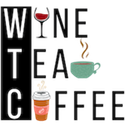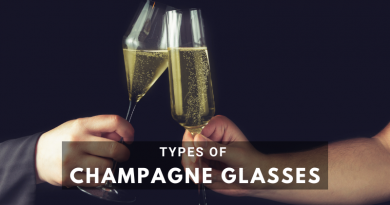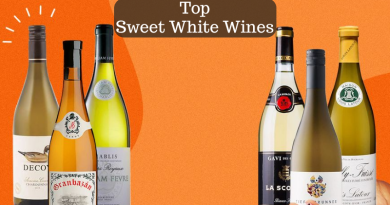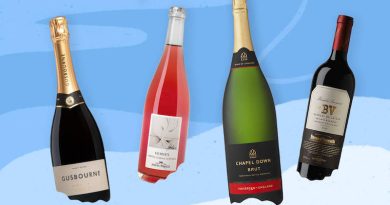Bordeaux Wine : The Complete Bordeaux Guide
Bordeaux is one of the most famous wine regions in the world, known for producing some of the most exceptional wines available. With over 7,000 chateaux producing wine in the region, it can be overwhelming to navigate the vast selection of wines available. Whether you’re a seasoned wine enthusiast or just beginning to explore the world of wine, this complete guide to Bordeaux wines will provide you with everything you need to know. From the history and terroir of the region to the different grape varieties used in production and the various wine classifications, this guide will provide you with the knowledge to select and enjoy the best Bordeaux wines for any occasion or budget.
The History of Bordeaux Wine
Bordeaux wine has a long and storied history that dates back to the Roman era. This wine region in southwestern France has gone through significant changes and has evolved over the centuries to become one of the most significant wine-producing regions in the world. In this article, we’ll take a deep dive into the history of Bordeaux wine and explore its evolution and the impact of historical events on its production and trade.
The Evolution of Bordeaux Wine Over the Centuries
The history of Bordeaux wine dates back to the Roman era, when the Romans introduced vineyards to the region. However, it wasn’t until the Middle Ages that wine production in Bordeaux really took off. During this time, wine became a significant trade commodity, and the region’s wines were exported to England, Belgium, and the Netherlands.
During the 17th and 18th centuries, the Bordeaux wine industry experienced significant growth and development. The region’s vineyards expanded, and winemakers began experimenting with new techniques, such as barrel aging and blending, which would become hallmarks of Bordeaux wine production.
In the 19th century, Bordeaux wine entered its golden age, with the 1855 Classification being the most significant event of the century. This classification system ranked the region’s wines based on their quality and prestige, and it is still used today. The 1855 Classification elevated the status of Bordeaux wines, making them some of the most sought-after and prestigious wines in the world.
The 20th century brought significant changes to the Bordeaux wine industry. In the aftermath of World War I, the region’s vineyards were devastated, and it took years for the industry to recover. The 1930s brought new challenges, with the Great Depression leading to a decline in demand for luxury goods, including Bordeaux wine. However, the post-World War II era saw a resurgence of the industry, with the demand for Bordeaux wines increasing globally.
The Impact of Historical Events on Bordeaux Wine Production and Trade
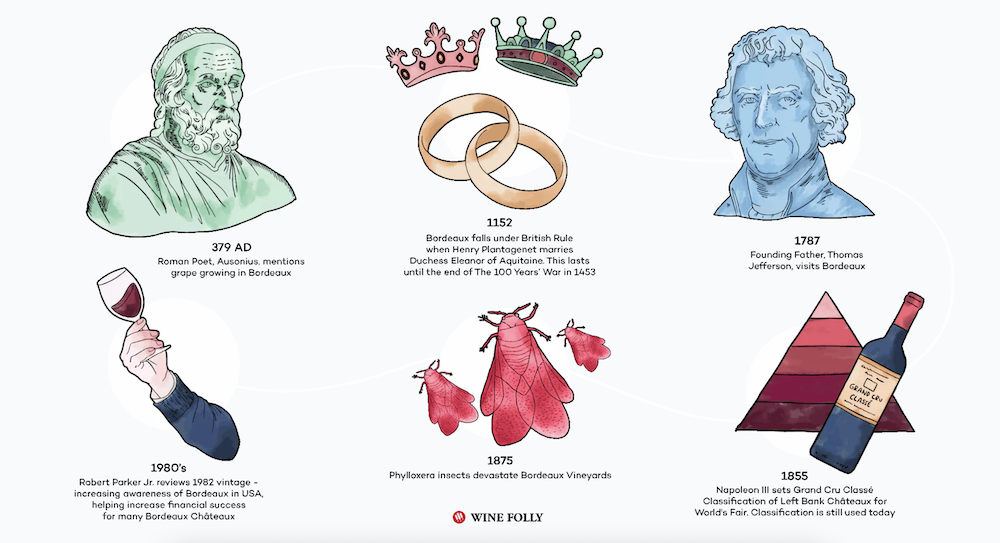
Historical events have had a significant impact on Bordeaux wine production and trade. For example, during the Middle Ages, Bordeaux wine production was driven by the region’s location on the Gironde estuary, which provided access to trade routes that linked the region to other parts of Europe. This access to trade routes allowed the region’s wines to be exported to other countries, which helped establish Bordeaux as a significant player in the wine industry.
During the 19th century, the phylloxera epidemic devastated vineyards across Europe, including in Bordeaux. This led to the destruction of many of the region’s vineyards and had a significant impact on the Bordeaux wine industry. However, the industry was able to recover and adapt by grafting European vines onto American rootstocks, which were resistant to the phylloxera pest.
In the 20th century, political and economic events had a significant impact on Bordeaux wine production and trade. The two world wars had a devastating impact on the region’s vineyards, and it took years for the industry to recover. The 1970s and 1980s brought new challenges, as the region faced increasing competition from New World wine producers, particularly in California and Australia.
n conclusion, the history of Bordeaux wine is a long and fascinating one that spans centuries. The evolution of Bordeaux wine has been shaped by historical events, such as the Middle Ages, the 1855 Classification, the phylloxera epidemic, and the two world wars. These events have had a significant impact on Bordeaux wine production and trade, and the industry has adapted and evolved to overcome these challenges.
The Unique Characteristics of the Bordeaux Region and Its Terroir
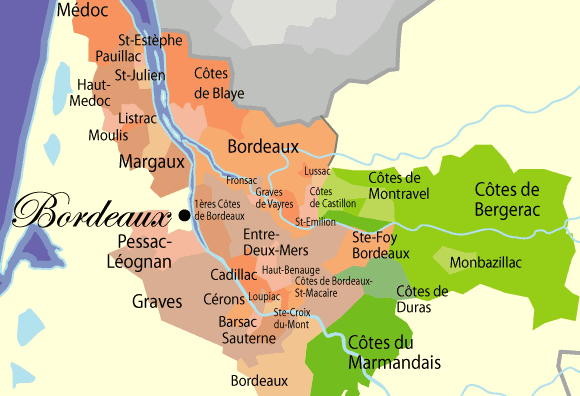
The Bordeaux region is located on the Atlantic coast of southwestern France and is bisected by the Gironde estuary. The region is divided into two distinct areas: the Left Bank and the Right Bank. The Left Bank, which includes the Médoc and Graves regions, is known for producing Cabernet Sauvignon-dominant blends, while the Right Bank, which includes the Saint-Émilion and Pomerol regions, is known for producing Merlot-dominant blends.
Bordeaux’s terroir is unique, with a combination of factors that make it ideal for wine production. The region’s moderate maritime climate, which is influenced by the Atlantic Ocean and the Gironde estuary, provides mild winters and warm summers, which are ideal for grape growing. The region’s location also protects it from extreme weather conditions, such as frost and hail, which can damage the vines.
The Influence of Soil, Climate, and Topography on the Wine Produced in Bordeaux
Soil is a crucial component of Bordeaux’s terroir, with a diverse range of soils found throughout the region. The Left Bank’s gravelly soils, which are rich in mineral content, provide excellent drainage and help regulate the vine’s water supply. The Right Bank’s clay and limestone soils are less well-draining, which can lead to higher water content in the grapes, resulting in softer, fruitier wines.
Climate is another critical component of Bordeaux’s terroir, with the region’s moderate maritime climate playing a significant role in the quality and style of the wine produced. The climate’s influence on the ripening of the grapes is a crucial factor in determining the wine’s style and structure.
Topography also plays a role in Bordeaux’s terroir, with the region’s varied landscape providing unique growing conditions. The area’s undulating hills and valleys create a diverse range of microclimates, which can have a significant impact on the wine’s flavor profile. The region’s elevation can also impact the vine’s exposure to sunlight, which can affect the ripening of the grapes.
Overview of the Primary Grape Varieties Grown in Bordeaux
Bordeaux’s most common grape varieties include Cabernet Sauvignon, Merlot, Cabernet Franc, Petit Verdot, and Malbec. These grape varieties are typically blended to create Bordeaux’s signature red wines, although some winemakers also produce single-varietal wines.
Cabernet Sauvignon is the most widely planted grape variety in Bordeaux and is grown primarily in the Left Bank region of the Gironde estuary. Merlot is the second most commonly planted grape variety in Bordeaux and is grown primarily in the Right Bank region. Cabernet Franc is also widely planted in the region and is often used to add complexity and balance to Bordeaux blends. Petit Verdot and Malbec are less commonly planted in Bordeaux but are still used to add color, tannins, and flavors to Bordeaux blends.
Characteristics of Each Grape Variety and Its Role in Bordeaux Wine Blends
Cabernet Sauvignon
Cabernet Sauvignon is known for its high tannin levels, which give it structure and longevity in Bordeaux blends. The grape is known for its black fruit flavors, such as black currant, and often contributes aromas of graphite, tobacco, and cedar. Cabernet Sauvignon is typically blended with Merlot and Cabernet Franc to create Left Bank Bordeaux blends, where it provides structure and complexity.
Merlot
Merlot is known for its soft, round tannins, which give it a fleshy, silky texture. The grape is known for its red fruit flavors, such as raspberry and plum, and often contributes aromas of chocolate and coffee. Merlot is typically blended with Cabernet Sauvignon and Cabernet Franc to create Right Bank Bordeaux blends, where it provides fruitiness and balance.
Cabernet Franc
Cabernet Franc is known for its spicy, peppery notes and herbal aromas. The grape is typically used in small quantities in Bordeaux blends to add complexity and balance, as well as to soften the tannins. Cabernet Franc is often blended with Cabernet Sauvignon and Merlot to create Left and Right Bank Bordeaux blends.
Petit Verdot
Petit Verdot is known for its high tannin levels and its powerful, full-bodied character. The grape is typically used in small quantities in Bordeaux blends to add color and structure, as well as to contribute aromas of black fruit, violet, and earth. Petit Verdot is often blended with Cabernet Sauvignon and Merlot to create Left and Right Bank Bordeaux blends.
Malbec
Malbec is known for its inky color and its juicy, fruity character. The grape is typically used in small quantities in Bordeaux blends to add color and fruitiness, as well as to contribute aromas of blackberry and spice. Malbec is often blended with Cabernet Sauvignon and Merlot to create Left and Right Bank Bordeaux blends.
The Five Official Bordeaux Wine Classifications
1855 Classification
The 1855 Classification is one of the most famous wine classifications in the world and was established for the Exposition Universelle de Paris in 1855. The classification ranked the best Bordeaux wines based on the prices they had achieved over the previous 20 years. The classification included 61 Châteaux, with five being awarded the prestigious Premier Cru status. These Premier Cru wines include Château Lafite Rothschild, Château Margaux, Château Latour, Château Haut-Brion, and Château Mouton Rothschild.
Saint-Émilion Classification
The Saint-Émilion Classification is another important Bordeaux classification system, established in 1955, that ranks the best wines produced in the Saint-Émilion region. The classification is reviewed every ten years, and wines can move up or down in the rankings based on their quality. The current classification includes four levels: Premier Grand Cru Classé A, Premier Grand Cru Classé B, Grand Cru Classé, and Grand Cru.
Graves Classification
The Graves Classification is a classification system used in the Graves sub-region of Bordeaux, established in 1953. The classification ranks the best red and white wines produced in the region, with the best red wines classified as Cru Classé and the best white wines classified as Cru Classé de Graves.
Crus Bourgeois Classification
The Crus Bourgeois Classification is a classification system established in 1932 for the best wines produced in the Médoc region of Bordeaux. The classification includes three levels: Cru Bourgeois, Cru Bourgeois Supérieur, and Cru Bourgeois Exceptionnel.
Sauternes and Barsac Classification
The Sauternes and Barsac classification is based on the sweet white wines produced in the region. It includes one level of classification, Premier Cru Supérieur, and 27 chateaux are included in this classification.
A Guide to the Top Bordeaux Wines for Different Occasions and Budgets
When it comes to Bordeaux wines, the price can vary widely depending on the producer, vineyard, and vintage. However, there are excellent Bordeaux wines available at every price point. Here are some top Bordeaux wines for different occasions and budgets:
- Budget-friendly Bordeaux wines: Bordeaux Supérieur, Château Tour Bayard, and Château Les Grands Maréchaux
- Mid-range Bordeaux wines: Château Poujeaux, Château Malescot St-Exupéry, and Château Prieuré-Lichine
- High-end Bordeaux wines: Château Margaux, Château Lafite Rothschild, and Château Latour
- Celebratory occasions: Château Cheval Blanc, Château Haut-Brion, and Château Mouton Rothschild
Tasting Notes and Recommendations for Some of the Most Popular Bordeaux Wines
Here are some tasting notes and recommendations for some of the most popular Bordeaux wines:
- Château Margaux: This Premier Cru Bordeaux is known for its elegance, complexity, and longevity. It has a silky texture with notes of black currant, tobacco, and leather.
- Château Lafite Rothschild: Another Premier Cru Bordeaux, this wine is known for its finesse, balance, and refined tannins. It has a complex bouquet with notes of blackberry, cedar, and graphite.
- Château Cheval Blanc: This Premier Grand Cru Classé A wine is known for its powerful yet graceful character, with notes of black cherry, spice, and chocolate. It’s an excellent choice for celebratory occasions.
- Château Haut-Brion: This Premier Cru Bordeaux has a rich, full-bodied character with notes of black fruit, smoke, and earth. It’s an excellent choice for pairing with rich meat dishes.
- Château Prieuré-Lichine: This mid-range Bordeaux wine is known for its smooth texture and fruity character, with notes of blackberry and vanilla. It’s an excellent choice for pairing with grilled meats and hearty stews.
- Bordeaux Supérieur: This budget-friendly Bordeaux wine is an excellent choice for everyday drinking, with a fruity character and smooth finish. Château Tour Bayard and Château Les Grands Maréchaux are two excellent examples of Bordeaux Supérieur.
A Guide to Visiting the Bordeaux Wine Region, Including Tips for Planning a Trip and Must-See Attractions
- When to Visit: The best time to visit Bordeaux is from May to October when the weather is warm and sunny, and the vineyards are lush and green. However, this is also the busiest time of the year, so it’s best to book your accommodations and tours in advance.
- Where to Stay: Bordeaux is a popular destination, so there are plenty of accommodation options available. If you’re looking to stay in the heart of the city, there are many hotels and Airbnb options available. However, if you want to stay closer to the vineyards, consider staying in one of the many chateaux that offer guest rooms.
- Must-See Attractions: The Bordeaux wine region has much to offer beyond the wine itself. Here are some of the top attractions to see during your visit:
- Saint-Émilion: A UNESCO World Heritage Site, this medieval town is home to some of the most exceptional wines in the region and is a must-visit for wine enthusiasts.
- Bordeaux City: The city of Bordeaux is a beautiful and historic city, with many excellent museums, restaurants, and wine bars to explore.
- The Cité du Vin: This museum is entirely dedicated to wine and is a must-visit for any wine enthusiast. It offers interactive exhibits, wine tastings, and stunning views of the city.
- Getting Around: The best way to explore the Bordeaux wine region is by car. There are also many bike tours available for those who prefer a more active approach.
Recommendations for Bordeaux Wine Tours and Tastings
- Grand Cru Classé Tasting: Many chateaux offer tastings of their Grand Cru Classé wines. These tastings offer an opportunity to taste some of the most exceptional wines in the region.
- Wine and Food Pairing: Wine and food pairing is an essential aspect of the Bordeaux wine experience. Many chateaux offer wine and food pairing experiences, where you can taste some of the most exceptional wines paired with local cuisine.
- Wine Tours: There are many wine tour operators in Bordeaux, offering a wide range of experiences. Some tours include tastings at multiple chateaux, while others offer a more in-depth look at the winemaking process.
- Bordeaux Wine Festival: If you’re visiting Bordeaux in late June, be sure to attend the Bordeaux Wine Festival. This festival is a celebration of the wine culture of Bordeaux and offers an opportunity to taste some of the most exceptional wines in the region.
